There is nothing worse than being in the middle of cooking or baking and realizing you’re all out of butter.
Since butter is such a common ingredient, it’s easy to assume that you’ll already have it on hand when you need it most. Unfortunately for me, I’ve incorrectly made this exact assumption far too often. Over time, I’ve discovered a number of helpful substitutions that can get you by in a pinch.
Here are 7 of my favorite butter alternatives. I’ve also added my own time-tested advice about which cooking and baking situations each option is best suited for.
In This Article
7 Great Substitutes For Butter
1. Margarine or Plant-Based Butter
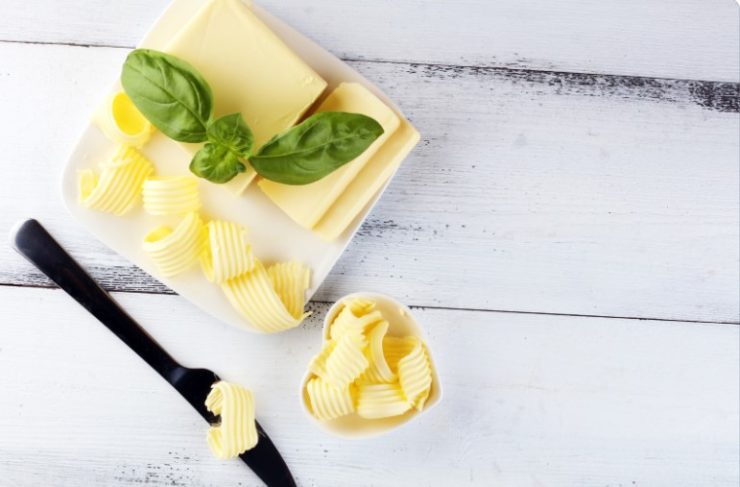
These butter-flavored oil or nut spreads are great substitutions for butter whether you are making a sweet or savory dish. Their butter flavor leaves no unexpected tastes in the recipe.
These substitutions also have a similar consistency to butter and are perfect for implementing into your recipes using a 1:1 ratio. Simply use the same amount of margarine or plant-based butter as you would regular butter.

Pro-Tip: Margarine or plant-based butter are the best options when working on a large-scale recipe since they will not alter the texture or taste of the finished product.
2. Shortening

Shortening is any fat that is solid at room temperature. This includes vegetable shortening like Crisco or even lard.
Shortening is another easy swap for butter since it substitutes at a 1:1 ratio. For every cup of butter needed, you can use a cup of shortening instead.
Vegetable shortening is often utilized in baking since it is flavorless and can give baked goods like cakes and cookies a lighter texture and a higher rise in the oven. It is also perfect for pie crusts to achieve a tender and flaky result.
Lard can vary in flavor from neutral and odorless to smoky and reminiscent of bacon. Neutral lard can substitute butter in both baking and cooking, whereas you should reserve the porky flavored lard for dishes that hold up against the added meaty flavor.
3. Oil
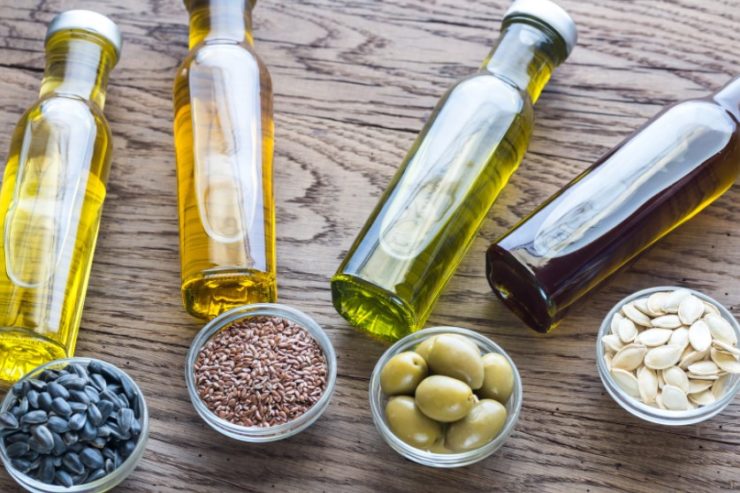
Oil is a great substitute for butter in many recipes, but you will need to consider the flavor of the oil and the amount of butter being substituted.
Butter is made up of about 80% fat and 20% water, whereas oil is 100% fat. So, when substituting oil for butter, use a 3:4 ratio. For every cup of butter called for, you will use only ¾ cup of oil.
Be aware of the flavor of the oil you choose to use!
Vegetable and canola oils are neutral and will not affect the taste of your finished meal. On the other hand, olive and coconut oils have robust and recognizable flavor profiles that will be noticeable in your dish.
Olive oil may be the best option for sauteèd vegetables in place of butter, but not in a vanilla cake where the flavor would overpower the baked good.
Instead, opt for the more neutral oils when making a dish with delicate flavors, or embrace the taste of the oil in the instance of an olive oil pound cake or tropical cake using coconut oil.

Pro-Tip: Coconut oil is the exception and can substitute butter using a 1:1 ratio. Opt for refined coconut oil if you’d prefer a less tropical flavor.
4. Mayonnaise
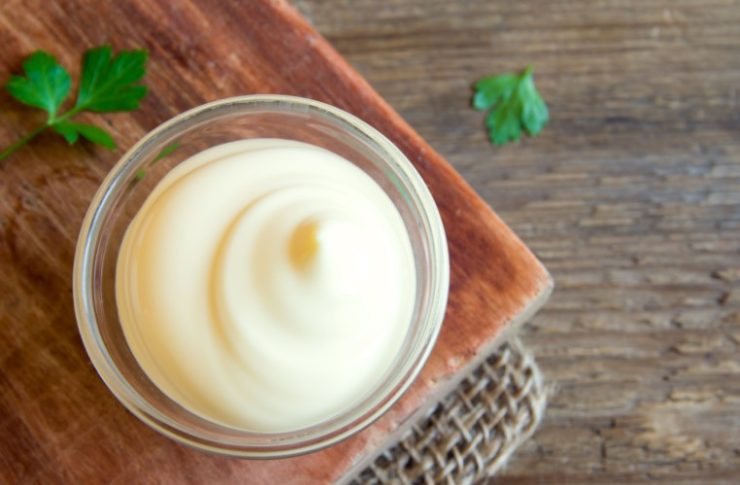
Mayo is mostly a combination of oil and egg yolks and aids in the moisture and richness of a recipe, just like butter.
Use mayonnaise in place of butter in savory meals like fried eggs or mashed potatoes, but don’t count it out when you are making sweet desserts either. Best used when paired with a strong sweet flavor, like chocolate, you can use mayo in place of butter to make the most decadent chocolate cake you’ve ever tasted.
Because of the looser consistency, start with a 3:4 ratio of mayo to butter in your recipes, then adjust as necessary.

Pro-Tip: My favorite way to make a grilled cheese is to use mayo on the sides of the bread that will be grilled instead of butter. It creates a perfect edge-to-edge crust with a mouth-watering rich flavor in every bite.
5. AppleSauce
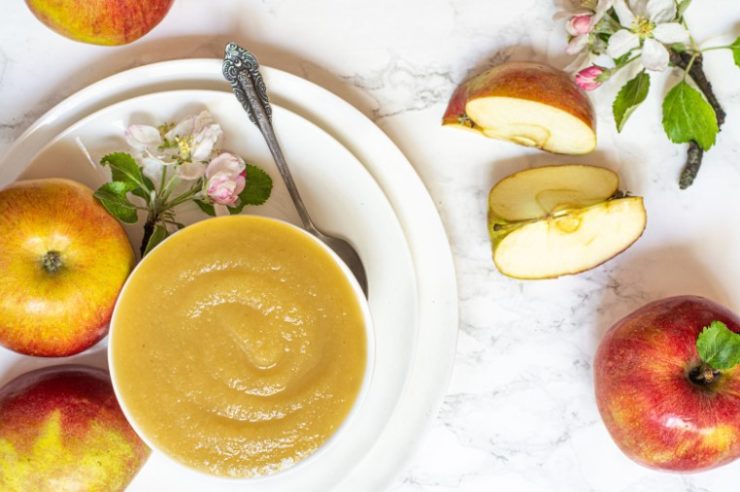
Applesauce is a great butter substitute in weighty baked goods like bread or muffins. The applesauce adds moisture that does not create density but keeps the batter light and fluffy.
Applesauce substitutes for butter at a 1:1 ratio, but use your best judgment and keep an eye on the texture of your batter.
Unsweetened applesauce is preferable; otherwise, you may have to adjust the sugar in your recipe to balance out the added sweetness.
6. Bananas

Bananas are a special case substitution for butter and only really work in dense baked goods like bread, muffins, pound cakes, and some cookies, like oatmeal cookies.
Bananas can be swapped for butter using a 1:1 ratio.
The bananas should be soft, ripe, and mashed before using in your recipe.
You can expect a more fruity flavor than if you had used butter and a thick and moist result.
7. Greek Yogurt
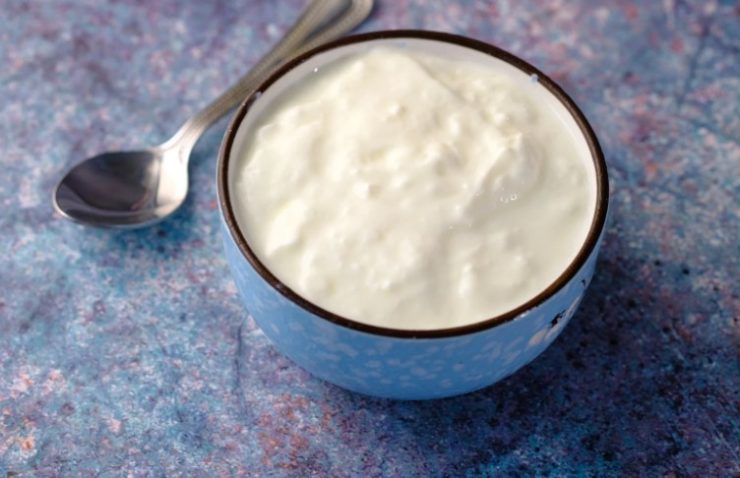
Full-fat Greek yogurt is a welcome alternative to butter in recipes, but be sure to opt for the full-fat version to achieve something similar to if you had used butter.
If you use cultured butter in your home, the tanginess from the Greek yogurt will be comparable to that taste; otherwise, consider there will be a tart and tangy flavor from the yogurt.
Greek yogurt can be substituted for butter in a recipe using a 1:1 ratio, as long as the amount of butter needed is 1 cup or less.
Tips For Working With Butter Alternatives
When swapping butter for a substitute with higher moisture content, like oil, mayo, applesauce, bananas, and greek yogurt, you risk altering the finished product’s consistency.
To avoid this, use wetter substitutions only when less than a cup or so of butter is needed unless you feel comfortable tweaking the recipe as you go.
If the recipe calls for more than 1 cup of butter, and you only have the wetter substitutions on hand, increase the flour in the recipe by about ¼ cup or reduce the liquid by about ¼ cup. You may still need to add dry or wet ingredients to achieve the desired consistency.
Frequently Asked Questions
What is the best butter substitute when baking?
Shortening or margarine is the best butter substitute for baking since it will maintain the baked goods’ desired flavor and texture.
What is the best oil to use in place of butter?
Neutral flavored oils like vegetable or canola oils are the most versatile to use in place of butter.







